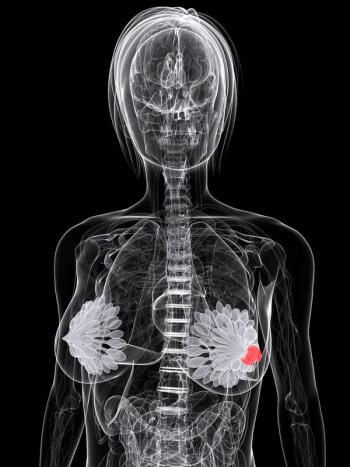
Breast Cancer Patients Prefer Radiation to Axillary Lymph Node Dissection
Breast cancer patients who had an axillary lymph node dissection had more complications compared with those who underwent radiotherapy for node-positive disease.
Lymph node axillary radiotherapy is associated with significantly fewer side effects compared with the more traditional axillary lymph node dissection or removal technique. Patients who had a lymph node dissection had more complications compared with those who underwent radiotherapy. For example, at 5 years after treatment, lymphedema rates were two times higher in patients who had a lymph node dissection compared with those who had radiotherapy.
These results, from an international prospective clinical trial led by the European Organisation for Research and Treatment of Cancer (EORTC), were presented at the 15th Annual Meeting of the American Society of Breast Surgeons held April 30–May 4 in Las Vegas.
The AMAROS (After Mapping of the Axilla: Radiotherapy or Surgery?) trial compared the outcomes of these two techniques in 4,806 women who had breast cancer with positive sentinel nodes. Patients in the study were enrolled between 2001 and 2010; 744 patients had a lymph node dissection and 681 received radiotherapy.
At 1 year following treatment, lymphedema rates were lower in women who had radiotherapy compared with lymph node dissection or removal (15% vs 25%; P < .001). Women who had both radiotherapy and a dissection or removal had an even higher incidence of lymphedema compared with those who received radiotherapy alone (59%; P < .001). After 5 years, these rates were 10%, 21%, and 58%, respectively (P < .001). Independent risk factors for lymphedema within the first year of treatment were lymph node dissection, combination of a dissection plus radiotherapy, a body mass index of greater than 25, premenopausal state, and treatment on the dominant side.
No significant differences in shoulder mobility were seen between the lymph node dissection and lymph node radiotherapy groups. Ten percent of patients in the lymph node dissection group had paresthesia of the arm compared with 9% of those in the radiotherapy group.
Complications occurred in 23% of patients who received a lymph node dissection compared with 9% in patients undergoing radiotherapy (P < .001).
“These morbidity data strongly support the use of lymph node radiotherapy as the preferred treatment [for breast cancer patients with a positive sentinel node],” said study author Mila Donker, MD, of the Netherlands Cancer Institute, Antoni van Leeuwenhoek Hospital, who presented the study at a press briefing at the meeting. “The combined treatment [of a lymph node dissection with radiotherapy] should be avoided,” she added.
“Surgeons are trying to get away from axillary surgery because of the complication rate, and this is a nice demonstration that we do have alternatives to reduce local recurrence rates with radiation therapy and that we can potentially avoid surgery in these patients,” said briefing moderator Deanna Attai, MD, a breast surgeon at the Center For Breast Care in Burbank, California.
Newsletter
Stay up to date on recent advances in the multidisciplinary approach to cancer.
















































































